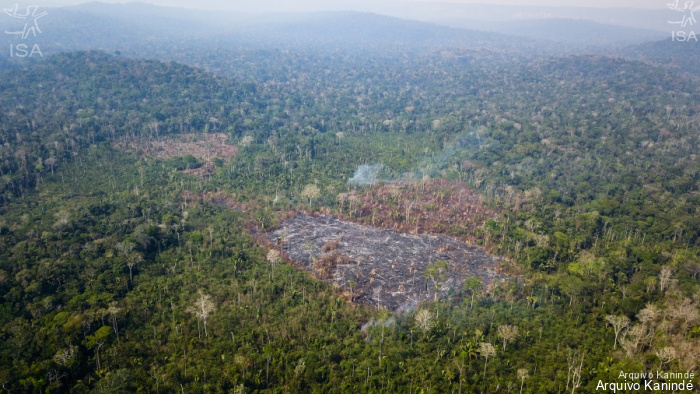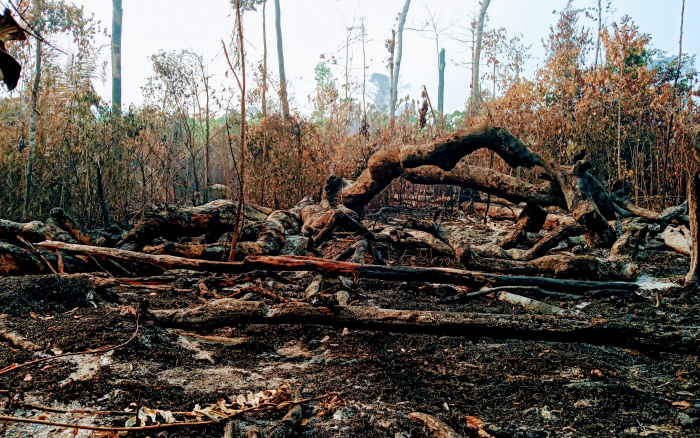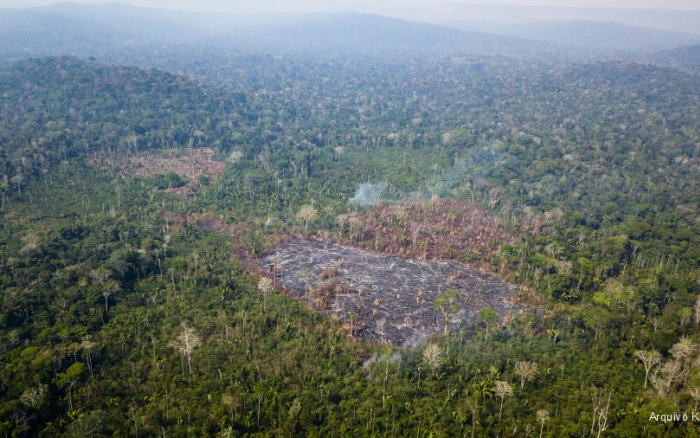Você está na versão anterior do website do ISA
Atenção
Essa é a versão antiga do site do ISA que ficou no ar até março de 2022. As informações institucionais aqui contidas podem estar desatualizadas. Acesse https://www.socioambiental.org para a versão atual.
With the Amazon Under Attack, Isolated Peoples Are Most Vulnerable
segunda-feira, 09 de Setembro de 2019 
Esta notícia está associada ao Programa:
A newly released ISA book presents an overview of the main threats to indigenous peoples in voluntary isolation, who are at risk of extermination if forest clearing continues.
Invasions, prospection, deforestation and fires have spiked in the Amazon since the election of Jair Bolsonaro. Under this scenario, all indigenous peoples are under threat, but some groups are in an extreme situation: isolated indigenous peoples. These are peoples who refuse contact with non-indigenous people and intrinsically depend on the forest for survival.
An ISA survey shows that the recent fires which have been devastating the Amazon have also reached territories inhabited by these groups. Since July, there have been 3,699 fires on territories with a presence of isolated peoples. The hardest hit territories are Rio Preto-Jacundá Extractive Forest (Florex), with 1,538 fires; Araguaia National Park (Parna), with 239 fires; Terra do Meio Ecological Station (Esec), with 188 fires; Xingu Indigenous Park, with 179 fires; and the Kayapó Indigenous Land, with 160 fires.
“(The invaders) set fire to what has been felled, but then it spreads and burns everything, the forest itself catches fire,'' says Awapu Uru-Eu-Wau-Wau about the fires which affect his territory in Rondônia, which has six records of isolated communities. The situation in the Tenharim/Marmelos Indigenous Land, South Amazonas, is also very serious, according to Ivanildo Tenharim. The fires are mostly spreading in the territory’s areas of Amazonian fields. There is a record of an isolated group there, on which information is being gathered.
The fires, in turn, are the consequence of an increasingly invaded and cleared forest. With changes in the political framework and frequent speeches by president Jair Bolsonaro against Indigenous Territories and other protected areas, prospectors, loggers and land-grabbers feel emboldened to enter these territories illegally.
“Enclosures and Resistance - Isolated Indigenous Peoples in Brazilian Amazonia” covers some of the more emblematic cases of the critical situation of survival of these groups, with the objective of alerting the Brazilian state, civil society, press and international organisations to the urgent need for protecting isolated indigenous peoples and their territories. We either act now or these populations run the risk of being massacred.
Organised by ISA, the book presents a current overview of the existence and situation of isolated indigenous peoples, and the fragility of their territories before the expansion of deforestation and enterprise development. It also contains chapters on the specific situations and challenges some peoples are faced with, thanks to the indispensable collaboration of various civil society researchers and professionals with long histories in the regions described, as well as indigenous partners who share their territories with isolated peoples and are today crucial for the protection of these groups.
Most of the isolated groups are aware of their non-indigenous surroundings, but have chosen to remain distant. Funai classifies this condition as voluntary isolation. Since 1987, Funai also has a no-contact policy, which respects this choice. Through Ethno-environmental Protection Fronts, Funai has worked to secure the protection of areas inhabited by these indigenous people, safeguarding their existence by keeping the forest standing and free from invaders. The book contains accounts from the coordinators of these fronts, lending weight to the words of those who live and operate in the most remote corners of the Amazon.
The systematisation and updating of the records of isolated indigenous peoples, based on the Funai registry and ISA database, identified the existence of 121 records: 28 confirmed, 26 under review and 16 ‘with information’. These records of isolated indigenous peoples are spread over 86 territories: 54 Indigenous Lands (TIs) and 24 Conservation Units (UCs - 15 federal and 9 state). Only one is outside of the Amazon, the Avá Canoeiro, which is under review. There are a further 8 areas with no form of protection.
Future Scenarios
In addition to the dismantling of socio-environmental protection policies, deforestation and planned infrastructure works for the Amazon are also a threat to these peoples. A scenario for 2039, prepared in partnership with ISA and the UFMG lists the impacts of the main works on the territories of these peoples.
In total, 133 planned infrastructure works for the Amazon will affect 52 protected areas (Indigenous Lands or federal and state Conservation Units), as well as 5 unprotected areas. In all, 92 records of isolated indigenous peoples will be under serious threat.
The study also addresses the cumulative effect of several works within the immediate vicinity of a same territory, affecting 20 records (7 under review and 13 with information) of isolated groups. These are: the integration of BR-163 with the Ferrogrão railway and the Amazon River waterway; the integration of BR-319 with the Amazon River waterway; and the integration between the waterways of the rivers Tapajós/Juruena/Teles Pires with the group of hydroelectric plants planned for these rivers.
The chapter also looks at forest loss occurring over the next 20 years if dismantling of socio-environmental protection policies in the Amazon is confirmed.
As such, over these two decades, 77 protected areas (54 TIs, 15 federal UCs and 8 state UCs) and seven unprotected areas will have lost a total area of 6 million hectares.
The results show that, by 2025, there could be a complete undoing of governance gains since 2005. In other words, the worst possible scenario would be a reversal, in only seven years, of all the progress made in reducing deforestation over the last 14 years.
Should this hypothesis be fulfilled, some protected areas will lose all forest coverage by 2039. These areas are TIs Cana Brava and Krikati (MA), Flona Bom Futuro (RO), Esec Três Irmãos (RO) and Resex do Rio Cautário (RO). Other areas will suffer almost complete deforestation, such as Rebio Gurupi (86%), Flona de Jacundá (83%), TI Arara do Rio Branco (80%), TI Awá (71%), TI Jacareúba/Katawixi (69%), TI Caru (66%), TI Araribóia (64%) etc.
Without the forest, these peoples will face death or traumatic contact. “There is no contact which is not bleak. All contact is tragic for various reasons, but overall for the drastic reduction of the population”, explains Karen Shiratori, anthropologist of the University of São Paulo and a contributor to the book.
“Brazil has the greatest number of peoples in isolation. This is incredible, imagine the wealth of this situation. There are people who have a way of life and who exercise their liberty in a completely different form to us”, she says. “It is interesting to think of isolation as an exercise in radical liberty. Not exactly as a voluntary choice but as an unequivocal manifestation of liberty.”
“This resistance portrays a sort of fury for living, an impossibility of a good life in any other form”, writes Uirá Garcia, in his chapter on the Awá. “They are people who are denying, at a very high price, an encounter with their own extermination.”
The objective of the publication, via a detailed overview of the subject, is to influence the three powers to paralyse invasions and deforestation on the territory of these peoples. Another important point is the strengthening of the Funai through its Ethno-environmental Protection Fronts, which are today one of the main instruments for the protection of these territories.
Download the book here.
Clara Roman
ISA
Imagens:






